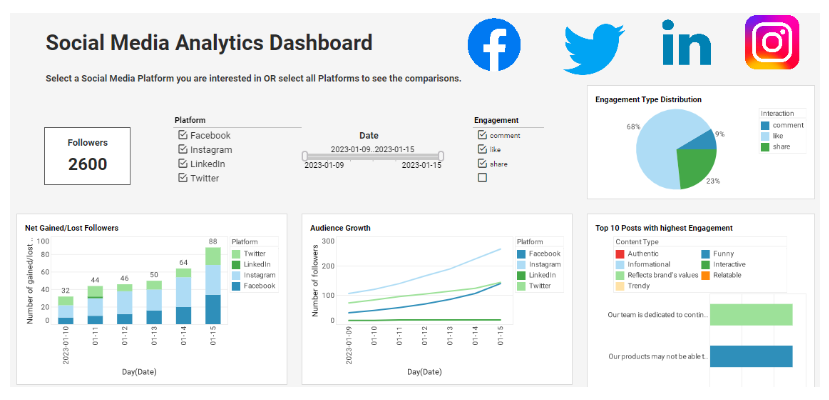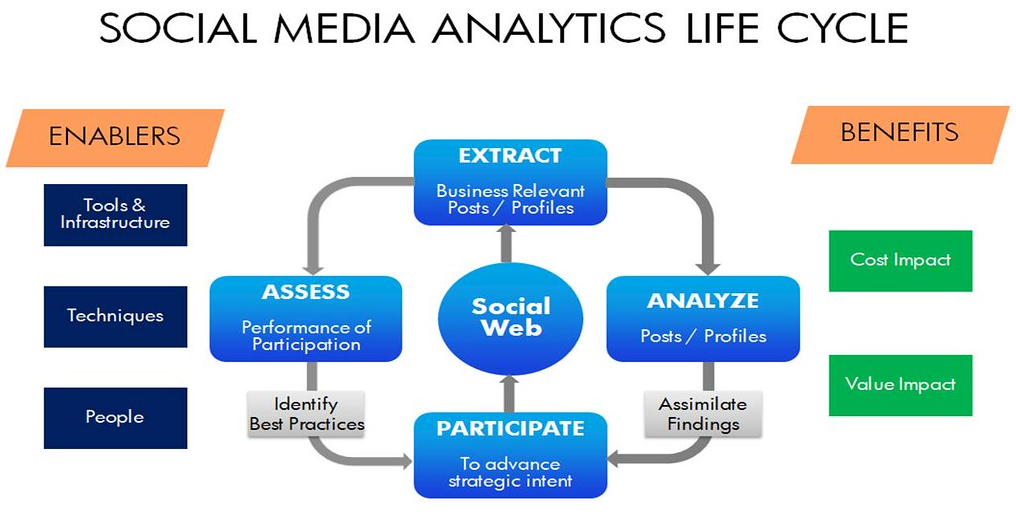Social media analytics is essential for monitoring and assessing the success of your marketing efforts. It covers a wide range of areas including performance metrics, audience demographics, competitor insights, paid ad results, brand sentiment and influencer impacts. Social media analytics focuses on the online experience of your customers, offering insights into their preferences, behaviors and trends.
The following article takes a deep dive into social media analytics, offering insights on how to leverage it into your marketing strategy.
The Importance of Social Media Analytics
Social media analytics entails collecting, analyzing and interpreting data from social media platforms. More than 4.95 billion people globally use social media, allowing them access to a vast data pool. Marketing managers and CMOs must use social media platforms to test new brand messaging, advertisements and offerings, and to gain direct, measurable feedback from target consumers.

Companies that use social media analytics have seen significant rise in customer satisfaction, positively impacting their overall financial performance. The analytics help marketers with a number of tasks including informing their strategy to planning campaigns and inspiring content ideas.
The following are the key benefits of tracking social media analytics.
Trendspotting
Trendspotting is the act of pinpointing upcoming trends before they become mainstream. Keeping a close watch on your social media analytics can help you do just that. Some of the key trends that your social analytics can help you determine include the following;
- Which social platforms are gaining or losing traction and popularity.
- Interesting topics that your audience is talking about including brand mentions in conversations.
- Types of advertisements that are of interest to your audience.
- Rising influencers and products in your sector or industry.
- Types of content that your audience engages with most.
If social analytics are analyzed properly, the reports can be very instrumental in identifying the type of content that you should post more of, the types of content that are becoming more popular and what your audience wants to hear about in the next quarter or year.
Brand sentiment
Brand sentiment refers to how people feel about your brand. It covers all positive, neutral and negative feelings that are discussed online. Looking through your social media analytics can help you to review and measure your brand sentiment. A sentiment analysis software can enable you to do that, ensuring your audience is happy with your brand.
It can also enable you to detect opportunities to make amends or correct any mistakes with unsatisfied customers. And, you could also discover opportunities to enhance your business. For example, sentiment analysis could help you to discover when customers are asking the same questions about a given product feature, so you can update your website’s FAQs page or help center.
Sentiment analysis can be used together with competitor analysis since you can pinpoint new competitors and related topics that your customers are buzzing about that you may have not considered before.
Setting social media goals
Social media analytics can also help you to discover the channels and content types that are performing well. That enables you to create actionable, realistic social media goals and objectives.
The main element that you should focus on is realistic. If you look at your social analytics and realize that your Instagram account is gaining 10 followers every week, trying to jump from 5,000 followers to 10,000 followers is one quarter is not a realistic goal, even if you change your posting strategy. Instead, you might try to make a goal where your account starts gaining 20 followers weekly and steadily grow it from there.
Check out the following tips on how to boost Instagram engagement for your brand or business.
Value perception
Also known as perceived value, the terms value perception refers to the overall customer opinion of your brand’s product or service and, whether or not it can meet their needs. Perceived value is essential to determining demand and the price point of a product or service. For instance, if your product has a low perceived value, customers will not be willing to pay much for it.
Social listening tools and monitoring data from other digital marketing dashboards like Google Analytics can enable you to measure value perception. That would guide the content you create to enhance value perception and ensure that you are showcasing how your product or your product can satisfy your customers’ needs.
Proving ROI
Your social media analytics can also help with proving Returns On Investment for your social media marketing efforts. Every time you run a new campaign, keep an eye on your social analytics to gauge how the content is performing. You should also monitor the analytics to determine if people are clicking over to your website and if you are generating new sales. That demonstrates social media ROI, enabling the marketing teams to earn more buy-in and resources. URL shortening and UTM tracking are the two ways that make proving ROI through social analytics even much simpler. That way, you can attribute certain purchases and specific pipeline to your social media efforts.
Social Media Analytics Best Practices
The complexity and vastness of social media analytics can make navigating it feel quite daunting. It entails an analysis of multiple factors including campaigns, trends, competitors, tools, platforms and ads. The following are some of the best practices to enable you make the most of social media analytics.
Segment your audience
An effective social analytics strategy emphasizes on understanding and segmenting your audience. The segmentation of your audience helps with tailoring your content and strategies to different audience groups, enhancing engagement and effectiveness.
The first step is to collect demographic data, such as age, gender, location and interests of your audience. Analyze the times and how different segments of your audience engage with your content. Then, create targeted content and strategies that align with every segment.
For example, if demographic data show a high number of female users in their thirties from urban areas with an interest in fitness, develop content specifically tailored to the preferences and lifestyles of your audience. If data shows that young adults interact more during evenings then, you should post content during those hours.
You should constantly adjust your strategy to boost engagement with different audience segments.
Identify the platforms to focus on
If you have time and resource constraints, it is important to identify the social media platforms that would yield the most benefit for your efforts.
For example, if your analytics show a stronger audience presence and higher engagement on TikTok than Facebook, it makes strategic sense to prioritize TikTok. Similarly, of your unique tone resonates more effectively on X, gaining a substantial following, you should allocate resources where they have the greatest impact.
Such targeted approach ensures efficient use of your resources and maximizes your presence on social media.
Select the right metrics
You should also set specific, measurable goals for your social media analytics efforts, laying emphasis on key metrics that resonate with your goals. Choose metrics based on specific elements such as user behavior, audience engagement, customer feedback and brand interactions. The key social media analytics metrics to consider include click-through rates, reach, conversion rates, sentiment analysis and engagement rates.
Choose the right social media analytics tools
Social media analytics tools automate the process of analyzing social media data through technologies such as data analytics, data mining and reporting.
Whenever you are choosing a tool, you must make sure it resonates with your objectives and provides features that boost your analytical capabilities. The right tool should have intuitive dashboard and provide customized reporting options for optimizing your analysis.
Advanced tools may also provide predictive and prescriptive analytics, drawing deeper insights such as negative sentiments and a hike in the number of tweets and messages from your data.
Here is a list of the best social media management tools for 2025.
Incorporate multiple data sources
Mixing up social media data with other business metrics is important for understanding your social media impact across various platforms. After choosing an appropriate analytics tool, link it with your social media profiles. That integration allows the tool to compile data from multiple channels into a single platform, providing a holistic view of your performance.
Identify a tool that can synchronize with all your social media accounts, consolidating data into one accessible dashboard. A unified platform can integrate even up to 30 social media channels, offering an extensive and all-encompassing analysis solution. That approach simplifies data management and boost strategic decision-making by offering a comprehensive analysis.
Conduct proper and regular reporting
It is critical to review and report your social media analytics regularly and thoroughly to effectively monitor progress and outcomes.
Managing and interpreting data from various sources can be complex, making it difficult to generate clear insights. Thus, adopting a simple and well organized analytics report template is important. Your chosen template should provide a balance between high-level overviews and granular data.
Such a meticulous approach provides a comprehensive understanding of your social media performance and supports deeper analysis, especially when evaluating the Returns on Investment for your social media marketing campaigns.

Common Mistakes to Avoid in Social Analytics
There are some common mistakes that can hinder the potential of your social media analytics efforts. The following are the most crucial mistakes to avoid in social media analytics.
Ignoring context
Data in isolation can be misleading. And, that is why it is very important to understand the context behind the numbers. For example, an increase in engagement could be due to positive or negative reasons. That means your interpretation and subsequent actions could be off the mark without context. You should always look beyond the numbers and consider external factors like social media trends, current events or even changes in the platform’s algorithms that might impact your data.
Focusing on vanity metrics only
Although social media likes and follower counts are easily measurable, they do not always translate into meaningful engagement or business results. It is important to dig deeper into metrics that show genuine engagement and conversion such as CTRs, time spent on your website from social referrals. You should also dig into your conversion rates from social media campaigns. Those metrics provide a more comprehensive view of how effectively your social media analytics efforts contribute to your overall business objectives.
Overlooking negative feedback
Social media analytics is not just about accolades; it is also a valuable source of constructive criticism. Thus, ignoring negative feedback can be harmful to the reputation of your brand and customer relations. Thus, you should address complaints or criticisms proactively. Besides, use that feedback as a learning opportunity to enhance your products, service and customer engagement strategies.
Are you looking to boost your social media reach and engagement? Get in touch with Superior Social Boost for the best results. We help brands to grow their presence and engagement on Facebook, TikTok, Instagram, YouTube, X and Google Business.

